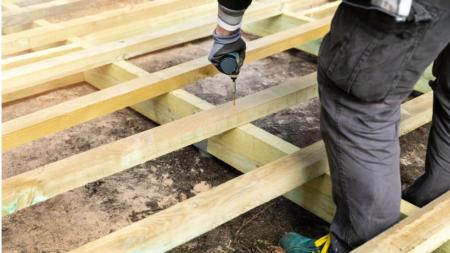
How to Extend Your Existing Deck?
Are you looking for innovative ways to extend your existing deck? We provide tips on how to build an affordable and easy deck extension. Read on to learn more!
Read Full StoryOne of the best ways to spend some free time is to relax with a book and your favourite drink on the deck.
As beautiful as a timber deck looks, maintaining it can sometimes be a hassle. If you love spending time on the deck, you will realise that the quality of a timber deck tends to deteriorate with prolonged use. A big issue is timber decking losing its shine, making the space seem dull, so deck oiling becomes necessary.

You’re in the right place if you want guidance on re-oil a deck. Undertaking timber deck maintenance is all a part of enjoying the stunning look and feel of your perfect outdoor space. We have compiled some information on applying oil on a timber deck to make the process easier. Hopefully, this guide will thoroughly prepare you for the inevitable renovation day.
Now, without further ado, let’s learn how to prepare a deck for oiling!
Installing timber decking is not expensive, so many people prefer timber over concrete. However, it can be a little costly for special finishes like anti-slip or getting rid of a termite infestation. Additionally, it can lose its lustre with time due to all the movement and activity on the wood.
Oiling is a must to keep the deck looking new and fresh. We suggest oiling your deck every 12-24 months and sanding when necessary. It does not need to be done regularly, but the timing is essential as the deck needs to hold the oil.
Sometimes, people want to oil a brand-new deck to give it an extra shine, but that is unnecessary. As crucial as it is to oil your deck, it is also vital to wear it out a little in the sun, as it allows the timber to weather and ensures the tannins and deck oils in the wood are drained out.
Oiling a new deck can trap moisture in the timber, causing it to have a significantly shorter lifespan than letting it weather naturally beforehand.
Weathering the timber can take time, but the exact period depends on the timber and your climate; here in Sydney, this period is typically 6 to 12 months. However, if you are still unsure, keep an eye out for the colour of the wood. Once the timber is grey, it can absorb the oil and create a more effective coating.
Outdoor decks receive direct UV rays from the sun and may require sanding and oil regularly to maintain their glistening shine, and a new layer of oil is just the thing for it.

Sanding is by far the longest and most tedious part of re-oiling a timber deck, and it’s messy and often requires a lot of elbow grease. Starting with an orbital sander and 80-120 grit sandpaper, begin sanding a single board at a time.
Use a vacuum attachment and a ventilated mask around a pool or something that cannot get sand. An older deck will require more time and attention to remove the old oil.
If you have access to a belt sander, this will make sanding hard spots a little easier. Sanding is a dusty process, but removing any old decking oil is essential.
If you have a painted deck, start with a paint remover and return to sanding.
The first step in this process is preparing your timber decking for oil. We suggest doing this when there is no possibility of rain and the weather is relatively dry. Once the timber has appropriately weathered, you must clean or scrub it. The best way would be to use warm water, light soap and a stiff-bristled brush.
If you need deeper cleaning, you can use a cleaning solution to scrub and leave it on for 15 minutes; a quality deck cleaner and your standard garden hose will do the trick. After that, rinse the timber deck with a water hose and let it dry. Usually, the drying time can range between one to four days, after which you can apply the oil or wood stain.
After the timber deck is dry, you must pick a good quality oil. The ideal decking oil will highlight the timber and bring out the oil’s natural grain, texture, and colour. Additionally, it should be easy to apply, water-resistant, and, ideally, UV-resistant. If you purchased a quality oil, this wouldn’t be a problem.
Picking a decking oil with these qualities will help protect the wood, giving long-lasting results. You must choose a suitable applicator to ensure the oil is applied thoroughly. Since decks are usually quite large, we recommend using pads with a pole to cover as much area as possible. But large brushes or rollers also work as a great applicator.
Your local timber supplier will have extensive wood stain and decking oil options. If you’re in Sydney, call our friendly team, and we will happily help you find an eco-friendly oil.
After the deck cleaning and the waiting period, you can finally apply the first coat of decking oil. Remember to mix the oil properly before applying it to the coat. Also, make sure you read the instructions that come with the oil to determine the appropriate drying time.
Appropriate safety equipment is highly recommended, and decking oil can be toxic, so safety gloves and glasses are advised.
The best way to coat the deck’s surface would be to apply the oil straight in long, continuous strokes. This is usually much easier with a pole if the surface area is large, but you can also use a brush. Keep repeating it, row after row, until the deck has been thoroughly coated. However, try avoiding the edges of the deck. We will apply oil here later.
Once the first coat is done, leave the oil to dry based on the time given in the instructions. It’s time for the next coat; we recommend applying at least two coats. Consider a second coat or a third if you have heavy foot traffic or want a longer lifespan. You will have to repeat this process eventually. The good thing is that it will not be as time-consuming since you need less oil. Plus, once you have coated the deck, it will not absorb as much. If applying a fresh coat, do not add too much oil, as it won’t absorb.
We also suggest keeping a rag ready if more oil is applied accidentally. More oil will spoil the board and make the deck surface sticky. Additionally, the rag can be coated with any methylated spirit to help thin the excess oil.
And that’s it. You can apply a coat around the edges for added durability and another coating if the wood has deteriorated significantly. Still, usually, two coats are more than enough. Now, you only need to let it dry and enjoy your newly oiled outdoor deck.

As we mentioned before, picking the right deck oil is the most crucial step in this process because the oil guarantees a certain amount of protection and ensures the deck stays in good shape and natural colour for years to come.
There are two to choose from when picking decking oil- water-based and non-water-based. These are selected depending on what type of wood. Some of the most common timbers people use are Spotted Gum and Merbau.
Depending on the budget and the final look, you can pick water or non-water-based treatments. Water-based oils will give the deck a natural look instead of a dark one. The water-based oils ensure the board doesn’t flake or peel with time regarding benefits. Additionally, there are some non-toxic options as well.
However, if you want to darken the wood’s colour, we suggest using a non-water-based decking oil. Since they are more common, they are less expensive when compared to water-based ones. It also creates a much stronger layer; the timber does not dry out since these oils penetrate better.
There is a chance that you might have to restore the deck before re-applying any oil. This usually happens only with older decks that have been around too long. Decks need a little more work but can always be returned to life.
We recommend finding a professional service to help you out with this. Trained professionals are better equipped to deal with restoration of this kind. However, that does not mean that it is an impossible DIY project.
If you plan to restore the deck yourself, the first thing would be to buy protective gear to maintain safety. Also, buy some protective covers for any furniture or plants that may come in the way.
To restore the deck properly, you must sand it to make it smooth after washing. Sanding the deck will cause residual dust to fall over deck furniture and plants, so ensure you cover them correctly. Also, we strongly suggest doing this only if you are comfortable using a belt or palm sander.
While sanding, ensure all the fungus or mildew is removed, and the area is spotless. Although this can be time-consuming, it is crucial, so the smoothening must be done correctly. Proper sanding prevents potential damage and makes your deck last longer.
Once the sanding is over, you must sweep the area with a brush or broom. You could also vacuum the remaining dust away if the space is large. The idea is to ensure the deck is spotless and dust-free before the oiling.
And there you have it, a short guide on re-apply decking oil. We hope this informative information will help you bring your deck back to life.
Before we leave, we would like to share some advice. Remember that the timber needs to dry after oiling, so you must wait at least a week before bringing those deck chairs out. Also, it is unnecessary to do this alone, as plenty of professionals are available.
Our professional service can help make this job a lot easier for you. From planning an outdoor maintenance schedule to ensuring an appropriate cleaning solution beforehand, our experienced timber deck builders in Sydney are here to help. Contact our team if you want assistance staining your deck in Sydney.
On that note, we shall sign off. But we will see you very soon with many more guides.
Until next time!
Are you looking for innovative ways to extend your existing deck? We provide tips on how to build an affordable and easy deck extension. Read on to learn more!
Read Full StoryAre you starting a deck renovation project, but aren’t sure how to lay decking correctly? Follow our simple DIY guide to learn how to correctly lay your decking so it’s both safe and functional!
Read Full StoryLooking for ways to rejuvenate and protect your timber decking in Sydney? Go through our guide to know all about it! Let’s look at the best ways to maintain your timber deck.
Read Full Story

